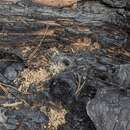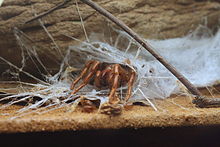en
names in breadcrumbs


Recent research on crop insecticides investigates the use of one of the very well-studied peptides in H. versuta venom, ω-hexatoxin-Hv1a (Hvt), as a biopesticide.This research is partially motivated by the evolved resistance of many pest insects to Bt toxin proteins.Because Hvt acts with a completely different mechanism from other pesticides, targeting voltage-gated calcium channels, affected species have not yet evolved any resistance, making it is a powerful novel poison (Akst 2014).
Tests show that Hvt effectively kills two major pest species of cotton and tobacco crops: African cotton leafworm (Spodoptera littoralis) and the tobacco budworm (Heliothis virescens). Hvt, as it turns out, also acts on a wider variety of pest species than does Bt protein, controlling non-Lepidopteran species, including aphids that cannot be controlled by Bt.Furthermore, researchers find that the toxin does not harm important beneficial insects that are used to control aphid populations – for example Chrysoperla carnea, the common green lacewing and Coccinella septempunctata, the seven-spot ladybird, both of which prey on aphids, and the wasp Aphidius colemani, an aphid parasitoid. Nor does Hvt protein negatively impact the western honey bee, Apis mellifera (Ullah et al 2014; Nakasu et al 2014).
Currently, Hvt has been approved as a spray-on product produced in yeast.The next step may be production of transgenic plants that can produce the Hvt protein themselves as a biocontrol agent. Studies show that transgenic plants expressing the Hvt protein discourage pests as effectively as the sprayed on product (Akst 2014).
The Blue Mountains funnel web, Hadronyche versuta, is one of six funnel web spiders found in eastern Australia, all of them venomous. Hadronyche versuta occurs in New South Wales, from the Blue Mountains to the Illawarra district.Its makes burrows in stumps and rotten logs, which are identifiable by threads of silk radiating from the entrance.
Like most funnel webs, H. versuta has a shiny black carapace (not brown, as are other trap door species). Hadronyche versuta is essentially impossible to distinguish from its close relative the Darling Downs funnel web (H. infensa) unless you are a spider taxonomist, but the two have distinct distributions so can be recognized by location.
Male spiders are about 20mm (0.75 inches) across in size.They live most of their lives inside their burrow, emerging once they have undergone their last moult (usually after a rain, as they are sensitive to dessication).Once they leave their burrow, males live only a couple days.They are active at night, and seek moist shelter during the day.Females reach about twice the size of males, with a more robust abdomen.They females are far longer-lived than males, with a lifespan of 10 or 20 years. Upon maturation, females leave their nest for the first and only time to set up their own burrow.Unlike males, they do not leave their burrow again, but hunt from the edge of the burrow entrance.They eat insects and other invertebrates, and also eat small vertebrates, such as frogs and lizards.
The venom of H. versuta, while not as severely dangerous as the venoms of other closely related funnel web spider species, is lethal to humans. A well-studied neuorotoxin, the venom acts within a couple hours.In 1981, an effective funnel web anti-venom was developed.This is available where funnel web spiders are found in Australia, and its proper application has prevents death from evenomations across Australian funnel web spiders species.A peptide in H. versuta venom, ω-hexatoxin-Hv1a (Hvt), is in the process of being developed as a highly effective biopesticide in crop plants, able to target pests without harming beneficial insect species. Use of Hvt as a pesticide is an example of how the expanding field of animal venom studies ("venomics") may have economic payoffs.
(Akst 2014; Atkinson 2013; CSIRO 2012)
Hadronyche versuta, the Blue Mountains funnel-web spider, is a venomous mygalomorph spider found in central New South Wales.
A member of the genus Hadronyche, the Blue Mountains funnel-web spider was first described in 1914, by William Joseph Rainbow in the genus Atrax, having been collected from the vicinity of the Jenolan Caves.[1] The species name is derived from the Latin versutus "clever/cunning".[2]
The Blue Mountains funnel-web spider has a similar colouration to most other Australian funnel-web spiders, namely a shiny black carapace and black to dark brown legs and chelicerae. The abdomen of the male has a pale dorsal patch, and that of the female is maroon-brown. The carapace in the male is slightly longer than wide and is roughly square in the female.[3]

The Blue Mountains funnel-web spider is found in eastern Australia from the Blue Mountains to Illawarra District in New South Wales. Its burrows are found in stumps and rotten logs.[3]
One out of nine recorded cases of being bitten by a Blue Mountains funnel-web spider has resulted in severe symptoms of envenomation. The bite can be successfully treated with the antivenom for the related Sydney funnel-web spider (Atrax robustus).[4] Symptoms of envenomation can occur within 15–20 minutes. Applying pressure bandage similar to snake bite treatment can significantly delay the onset of symptoms and remains a critical part of the management of an Australian funnel-web spider bite. Despite the venom lacking the atraxotoxin or atraxin of A. robustus, the symptoms are very similar to those from a Sydney funnel-web spider bite. Features of envenomation include diaphoresis, local pain at the bite site, pulmonary oedema, hypertension, nausea and vomiting.[5]
Females are suspected of being more venomous than males, possibly because they inject larger amounts of venom. Versutoxin, a neurotoxin very similar to robustoxin produced by the Sydney funnel-web spider, induces an autonomic storm in the victim.[5]
Hadronyche versuta, the Blue Mountains funnel-web spider, is a venomous mygalomorph spider found in central New South Wales.